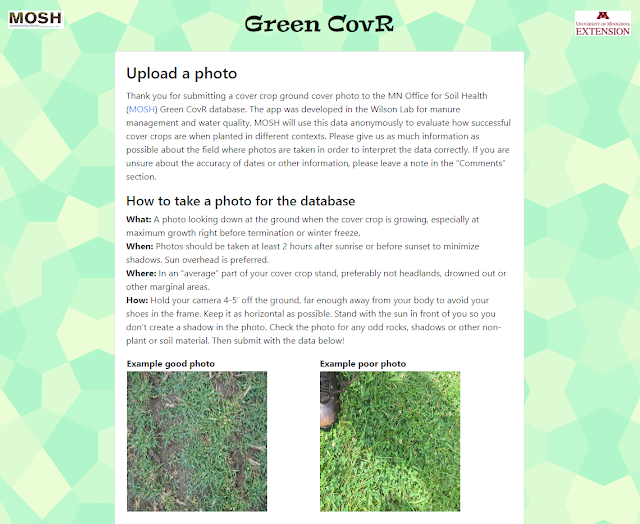GreenCovR: Cover crop management tool provides local information on green cover achieved by management
By: Bailey Tangen, Extension educator, water resources and soil health
If you or someone you know is growing cover crops this spring, help us get local data on cover crop growth that can provide context for cover crop management. Take a photo right before spring termination and submit it to z.umn.edu/green_covr.
We will also be looking to collect photos at the end of the 2024 growing season. The more data we have, the better likelihood we have of helping our farmers achieve cover crop success!
We know that cover crops grow differently across the state since Minnesota has a wide gradient in precipitation and temperature. The University of Minnesota is conducting extensive research on cover crops across the state, but data on locally suitable practices and cover crop species are critical to supporting effective cover crop management.
Data collected from previous years shows us that management strategy makes a big difference in the amount of green cover protecting the soil. The more green cover, the more soil protection, less nutrients and sediment in the water, and better for farmers’ bottom lines!

Join the ongoing effort for data collection
For every photo with cover crop management information you submit, your contact email will be entered in a drawing to win a $50 gift card. A winner will be selected for every 20 photos submitted. The deadline for entry is June 15th, and winners will be notified by June 30th.We will also be looking to collect photos at the end of the 2024 growing season. The more data we have, the better likelihood we have of helping our farmers achieve cover crop success!
Cover crop management in Minnesota
Cover crops are important soil covers during times when fields are normally left bare. These covers protect soil, water quality, and farmers’ bottom lines. But more green cover means that cover crops provide more benefit. It’s important to understand how management influences the amount of cover.We know that cover crops grow differently across the state since Minnesota has a wide gradient in precipitation and temperature. The University of Minnesota is conducting extensive research on cover crops across the state, but data on locally suitable practices and cover crop species are critical to supporting effective cover crop management.
Data collected from previous years shows us that management strategy makes a big difference in the amount of green cover protecting the soil. The more green cover, the more soil protection, less nutrients and sediment in the water, and better for farmers’ bottom lines!

Getting started
Head over to z.umn.edu/green_covr to get started. After selecting the ‘upload a photo’ box, you will be directed to upload your photo along with the management information. This management information is used at the county level, and your personal information will not be shared.Taking a good photo is key! Hold your phone at shoulder height (4-5 ft above the ground) and take a photo of an area representative of cover crop growth in your field. We're looking for photos taken from chest height of cover crops at their greatest point of growth—so right before frost for winter-killed crops and right before spring termination for winter-hardy crops.
Check out the results
When you click on the ‘Explore data’ box, you’ll be directed to interactive plots of the data. These graphs show data collected before 2023 and will be updated following this spring’s data collection.Explore different varieties of management strategies
The interactive data visualization allows you to explore the data by county, planting year, growing degree days, planting rate, and planting date. You can also explore the data by whether the cover crop was interseeded or not interseeded.By submitting images year after year, you will learn more about what impacts cover crop growth in your county. Make sure to join the ongoing effort for data collection this spring, submitting your spring cover crop photos to z.umn.edu/green_covr.
Don’t miss this opportunity to help with local data collection and to enter to a drawing to win a gift card!
References and Resources:
- Minnesota-specific cover crop research: z.umn.edu/MNcovercrops- Blog post: Growing cover crops in Minnesota: 4 great resources to get you started
Acknowledgement: This app was created by Melissa Wilson’s lab and Anna Cates, Extension soil health specialist.
---
For the latest nutrient management information, subscribe to the Nutrient Management Podcast wherever you listen and never miss an episode! And don't forget to subscribe to the Minnesota Crop News daily or weekly email newsletter, subscribe to our YouTube channel, like UMN Extension Nutrient Management on Facebook, follow us on Twitter, and visit our website.
If you have questions or comments, please email us at nutmgmt@umn.edu.
For the latest nutrient management information, subscribe to the Nutrient Management Podcast wherever you listen and never miss an episode! And don't forget to subscribe to the Minnesota Crop News daily or weekly email newsletter, subscribe to our YouTube channel, like UMN Extension Nutrient Management on Facebook, follow us on Twitter, and visit our website.
If you have questions or comments, please email us at nutmgmt@umn.edu.


Comments
Post a Comment